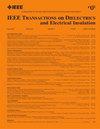基于磁流体动力学框架的光伏阵列直流电弧闪络建模与分析
IF 2.9
3区 工程技术
Q2 ENGINEERING, ELECTRICAL & ELECTRONIC
IEEE Transactions on Dielectrics and Electrical Insulation
Pub Date : 2024-12-16
DOI:10.1109/TDEI.2024.3518482
引用次数: 0
摘要
可再生能源系统仍然是能源行业发展最快的部门之一。考虑到近年来太阳能光伏阵列及其相应的直流装置在全球范围内的扩张,光伏系统的直流电弧闪光风险引起了人们的安全关注。结合几个具有相当大可用故障电流的太阳能光伏电路,有必要制定现实而精确的标准来评估直流设备中的电弧闪灭水平。与交流系统的电弧闪光相比,很少有研究和行业标准量化与光伏系统,特别是直流装置相关的风险。这项工作是对标准化模型开发做出贡献的一种尝试。首先对光伏系统中弧闪的物理特性进行了建模,然后利用磁流体动力学(MHDs)进行了仿真。利用ANSYS软件ANSYS Fluent对流体力学方程进行仿真,并结合ANSYS Maxwell对电磁方程进行仿真。由电力研究所(EPRI)开发的光伏阵列入射能量计算的经验模型及其公布的测试结果与MHD模拟结果以及某些其他可用的工业模型进行了比较。本文章由计算机程序翻译,如有差异,请以英文原文为准。
DC Arc Flash Modeling and Analysis of Photovoltaic Arrays Using Magnetohydrodynamic Framework
Renewable energy systems remain one of the energy industry’s fastest-expanding sectors. Considering the recent global expansion of solar photovoltaic (PV) arrays and their corresponding dc installations, the risk of dc arc flashes on PV systems has raised safety concerns. It is necessary to develop realistic and precise criteria to evaluate arc flash levels in dc equipment, combining several solar PV circuits with considerable available fault currents. In contrast to the arc flash of ac systems, few research studies and industry standards have quantified the risks associated with PV systems, particularly with dc installations. This work is an attempt to contribute to standardized model development. The physical aspects of arc flash in PV systems are modeled, and then magnetohydrodynamics (MHDs) are utilized to perform the simulation. The MHD simulation was performed through ANSYS software, ANSYS Fluent, for fluid mechanic equations in conjunction with ANSYS Maxwell for electromagnetic equations. The empirical model developed by the Electric Power Research Institute (EPRI) for incident energy calculation on PV arrays and their published test results are compared to the resultant MHD simulation results and to certain other available industry models.
求助全文
通过发布文献求助,成功后即可免费获取论文全文。
去求助
来源期刊
CiteScore
6.00
自引率
22.60%
发文量
309
审稿时长
5.2 months
期刊介绍:
Topics that are concerned with dielectric phenomena and measurements, with development and characterization of gaseous, vacuum, liquid and solid electrical insulating materials and systems; and with utilization of these materials in circuits and systems under condition of use.

 求助内容:
求助内容: 应助结果提醒方式:
应助结果提醒方式:


